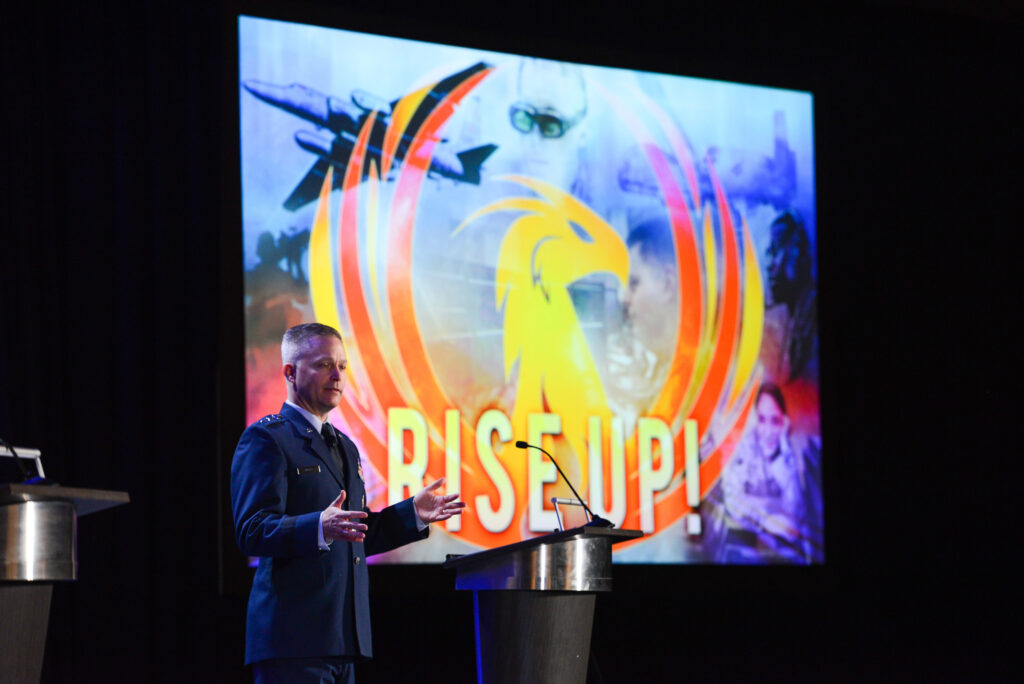
The head of the 16th Air Force discusses information warfare in 2019. FUSION is designed to enhance Air Force intelligence gathering and application.
ALBUQUERQUE: The 16th Air Force, designed to constantly contest the electromagnetic spectrum, has awarded a $95 million contract to support both command and control and service cryptologic element roles.
The contract — Full Spectrum Intelligence, Surveillance and Reconnaissance Operational Non-Appropriated Funds Support, or FUSIONS — was awarded to Scientific Research Corp of Atlanta. It will run through February 2026. In a sign that Scientific may have developed a promising approach, this is not the first award to the company for this sort of work. The Navy awarded the company a contract similar in scale and scope in 2018.
The 16th Air Force first started soliciting this contract in November 2019, one month after the command was created. The original solicitation emphasized the importance of “delivering timely and relevant intelligence data/products to the war fighter.”
The 16th was created by merging an Air Force cyber mission with an Intelligence, Surveillance, and Reconnaissance component. Combining intelligence collection in the same component as one that can launch attacks on computers is a way for the Air Force to show how closely connected cyber attacks are to online espionage. Cyber, like surveillance and activity in the electromagnetic spectrum, can happen below the threshold of a shooting war but can also be used for targeting and to inflict physical damage.
The scale of the investment is a sign of the Air Force’s commitment to fighting war effectively across all its domains, including cyber.
At a Dec. 11 symposium, Air Combat Command chief Gen. Mark D. Kelly said he’d told 16AF commander Lt. Gen. Timothy D. Haugh to “Take all of us, whether we go willingly, or kicking and screaming, into the non-kinetic competition.”
Much of the work of delivering data products to the Air Force will involve harnessing information it already has in its databases, and making them useful on a command level. Some of that work, as outlined in the solicitation, involves targeting products.
“The contractor shall provide targeting SME support regarding the Joint and Air Force Targeting Enterprise (JTE/AFTE), and kinetic, Electronic Warfare (EW), Information Operations (IO), Space and Cyber targeting,” reads the solicitation.
The contract is designed to support the 16th in its role as a “service cryptologic element,” or the formal mechanism by which signals intelligence components of the service work directly with the NSA.
Another component of the FUSIONS contract is identifying and recommending “new or unexploited information systems,” as well as “unique friendly, enemy, or neutral information sources,” with the goal of turning that information into relevant and useful intelligence.
This means, broadly, looking at new Internet-connected devices, tools, and networks, and making that information something troops at the tactical level can use. Vital to that intelligence collection and sharing is ensuring the data itself can be transmitted over existing DoD networks.
China’s new H-20 stealth bomber ‘not really’ a concern for Pentagon, says intel official
“The thing with the H-20 is when you actually look at the system design, it’s probably nowhere near as good as US LO [low observable] platforms, particularly more advanced ones that we have coming down,” said a DoD intelligence official.


























